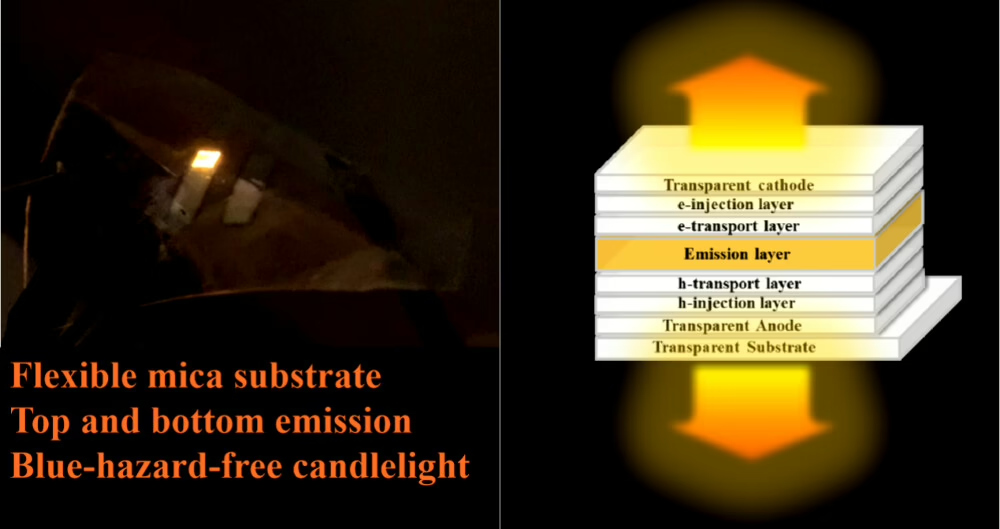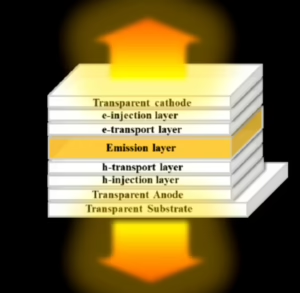Here’s something you might not know (meaning, I didn’t know), excessive exposure to blue-enriched white light can cause retinal inflammation, cataracts, and disruption of our circadian rhythms. When we’re exposed to this blue light at night, it can drastically suppress our body’s production of melatonin – the hormone that regulates our sleep cycles.

But there’s good news. Nature has given us a perfect example of healthy lighting – the humble candle. With its warm, amber glow characterized by a color temperature of around 1900 Kelvin, candlelight is physiologically friendly, disrupting our circadian rhythms much less than modern lighting. There’s just one problem – traditional candles release PM-2.5 particles (a common air pollutant) as they burn. Not exactly ideal for indoor air quality!
This is where remarkable research from a team at National Tsing Hua University comes in. In 2012, researchers led by Dr. Jwo-Huei Jou invented the first candlelight OLED, an electronic light source with the same gentle spectrum as candlelight, but without the smoke and fire hazards. But they wanted to go further.
Recently, this team has successfully created something extraordinary – a transparent, flexible candlelight OLED built on a mica substrate. When turned off, it’s 40% transparent, allowing you to see right through it. When powered on, it emits a warm, blue-hazard-free glow from both sides with a color temperature of just 1800 Kelvin.
Why does this matter? At 100 lux of brightness, a person could safely be exposed to this candlelight OLED for over 15 hours before reaching harmful levels for the retina. Compare that to just 404 seconds, about 7 minutes, for a typical 4000 Kelvin yellow-white light. Even more striking is what happens to your melatonin levels. Exposure to this candlelight OLED for 90 minutes at night suppresses melatonin by only 2%, compared to 13% suppression from yellow-white light. That’s a six-fold difference in how much your sleep hormone is disrupted!
What makes this technology truly revolutionary is its flexibility and transparency. Imagine light sources that can be integrated into curved surfaces, windows, or even wearable devices – bringing the eye-friendly qualities of candlelight to entirely new applications. The secret lies in the multi-layered design created by these researchers. They deposit a transparent indium tin oxide layer on flexible mica, then add carefully engineered organic layers that emit warm light when electricity flows through them. A thin silver cathode – just 20 nanometers thick – completes the device while still allowing light to pass through.
The team has tested this device under bending conditions, and remarkably, both the transparency and light emission remain stable. No cracks, no peeling – just consistent, healthy light.
This isn’t just about better lighting technology. It’s about reimagining our relationship with artificial light. For most of human history, we lived by the gentle glow of fire. Now, thanks to these researchers, we can bring that same quality of light into the modern era, without compromising on convenience or sustainability. Every night, billions of people expose themselves to light that disrupts their natural biological rhythms. What if we could change that? What if the light in your home could actually support your health rather than harm it?
This transparent, flexible candlelight OLED represents a step toward that future recreating the glow of the past. So the next time you turn on a light at night, consider this: the quality of that light might be just as important as the food you eat or the air you breathe. And now, thanks to innovative research, we have the technology to make healthier choices about how we illuminate our lives.
Reference
Chen, T.-H., Huang, X.-Q., Lenka, S., Sharma, D., Wang, H.-M., Wu, P.-H., Chen, S.-Z., Chu, Y.-H., & Jou, J.-H. (2025). Transparent Flexible Candlelight OLED. ACS Applied Electronic Materials, 7(7), 2720–2730. https://doi.org/10.1021/acsaelm.4c01959

